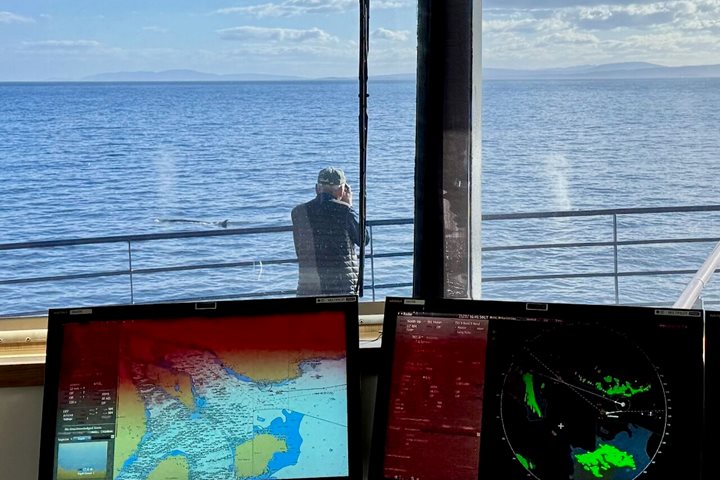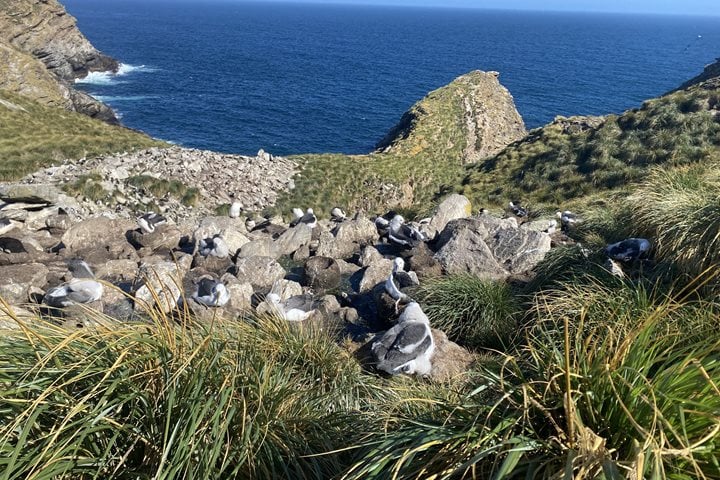We spent the night at anchorage in Fortuna Bay, which was fortunate for us as it gave us a nice, quiet, and calm night. The long bay is actually a flooded river valley that was carved out by glaciers long ago. First thing this morning, right after breakfast, we began going ashore at the idyllic valley that was once, not so very long ago, filled by a glacier. It has retreated far up the slope and has left behind this exposed broad plain. As we got ashore, no one was surprised to see numerous elephant seal mothers and pups being watched over by an enormous male. He snorted and bellowed as he tried to mate with a couple females, the whole time being watched by several human onlookers. A pond right above the landing was occupied by a flock of a dozen or so inquisitive South Georgia pintails. After a while, the ducks climbed out of the pond and walked over toward us…a rather remarkable behavior.
Ahead of us lay Fortuna Plain, backed by alpine mountains and ice fields inland and lower, less-craggy mountains on the two sides. We had come here to see a king penguin rookery, which is situated about a mile inland along the west side of the valley. King penguins were spread out from the beach all the way back to the rookery and beyond. Many of the adults we passed were molting. This indicated the breeding season is almost over, at least for this group, and we could expect to see fully grown chicks back at the rookery. And, that is precisely what we saw…thousands of ‘oakum boys.’ The name comes from the brown, wooly-looking down coats they sport at this time of their lives. Sailors of old thought they looked like big bundles of oakum, which is tarred fibrous material (usually made from old pulled apart hemp ropes) used to caulk wooden ships. Modern vessels made of steel or fiberglass have no need for oakum. The adults stop feeding their big chicks about now and the fledglings have to wait until their juvenal plumage molts in before they can go to sea and start feeding themselves. As we gathered on a low hill overlooking the grand sight of the colony, it was strangely reminiscent of the plains of Africa, only with penguins instead of wildebeest.This was our rendezvous point for the trekkers that we left ashore back at King Haakon Bay a couple days ago. It was good to watch them descend into Fortuna Bay and then rejoin their compatriots aboard ship. They had some wonderful stories to tell about their adventures.
In the middle afternoon, we entered Cumberland Sound and made a quick stop to drop off some eager hikers who wanted to hike across the middle peninsula by way of Bore Valley over to Grytviken, where they met back up with the ship. At Grytviken, we made our official entry into South Georgia and spent the rest of the afternoon enjoying the historic sites. Many of us went first to the old whalers cemetery in order to offer a toast (with some fine blended Highland Scotch whisky) to the ‘Boss,’ that is, Ernest Shackleton, whose mortal remains are interred here. Nearby are the ruins of the original shore-based South Georgia whaling station that was established in 1904 by Carl Anton Larsen, a famous Antarctic explorer in his own right. Whaling in these waters ended in the 1960s and the station has been abandoned since then. Today, it has been made safe for visitors and we were able to spend the latter part of the afternoon exploring the grounds and admiring old machinery, equipment, whaling boats, and also had time to visit the fine museum dedicated to the human history and natural history of the island. We invited the inhabitants of Grytviken aboard ship for cocktails and dinner, and a good time was had by all. The ship set sail soon after the meal was finished and we headed out of the bay towards tomorrow’s adventures.
Live from South Georgia—watch on Facebook!
Right now our climbing team is transiting the sub-Antarctic island of South Georgia making their way across the island to the ruins of Stromness whaling station. They are following in the footsteps of Sir Ernest Shackleton who made the same trek 100 years ago in a successful bid to save his entire crew of Endurance. Our trekkers will walk into Stromness tomorrow, and we’ll interview them live on National Geographic’s Facebook page!







